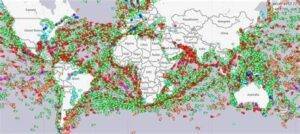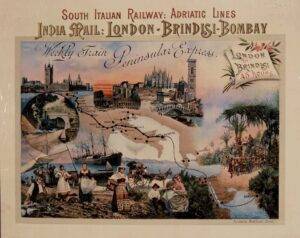By Leonardo Carbone, former Vice President EIRAC – Advisory to the EU Commission.
The 200.000 tons Evergreen vessel with a 20.000 TEU container (Twenty foot Equivalent Unit) capacity made the headlines last week but to the general public it was just a bit of news, curious if you like, but not as important as other news, whereas as a matter of fact it should be considered an alarm bell to make us reflect on how such an incident has a far reaching effect on the economy and on logistics, a vital element of any industrial process.
According to experts, daily traffic moving through the Suez Canal from the East to Europe is valued at 5.1 billion dollars and from the West to the East at 4.5 billion dollars, so it is easy to see how one day delivery delay means 9.1 billion dollars held up.
Though the vessel has been partially re-floated it will still take quite some time before normality returns to the Suez Canal. As of 29th of March 2021, 372 ships were queued up to go through the canal, including tankers, bulk carriers etc.

Again, according to experts, as of March 29th, 870.000tons of crude oil and 670.000 tons refined oil products are also stuck in the queue. The obvious consequence is the increase in the cost of these materials. Ports are also affected with the ghost of congestion looming in the future.
A spokesman for the most important container port of Europe, Rotterdam, stated that the longer it takes to re-establish normality in Suez Canal the worse for all ports.
He says that though Rotterdam has lots of storage space the berths and cranes to work vessels are limited so congestion and delays are guaranteed. More disruption in manufacturing.
Today, some of the major container carriers have announced they may go from the East to Europe circumnavigating Africa adding 13/14 days to their journey and thus increasing the daily costs by thousands of dollars.
So, one ship grounding in the canal has disrupted the whole shipping and logistic industry.
We are back, so to speak to a pre-Suez Canal era.
Before the opening of the Canal, all maritime traffic from/to Europe moved via Cape of Good Hope, circumnavigating Africa. Though, for example, it was acceptable for cargo to take six months to reach India, it was too much for passengers and mail to be on a vessel for that long. A novel system was developed around 1837, more cumbersome but able to cut down crossing time from six to two months.
People going East would go from the North Continent to Alexandria either by sailing directly or through France and Italy taking ship at Venice or Brindisi. From Alexandria 84 miles of desert by horse-drawn wagons to Cairo. From Cairo sailing by barge on the Nile and the Mahmoudieh Canal to Suez and from there with another vessel to final destination whether it be Bombay or Hong Kong. This was known as the overland route.

Logistically it was also quite a challenge because the coal needed for the engines had to come from Europe.
It was sent from Wales to Aden and other stocking ports en route to China, via the Cape. Aden was chosen as a stocking port as it was roughly the midway point of the voyage to Bombay or Colombo, other stocking ports.
The most important line of the time, Peninsular & Orient Line, employed about 170 sailing colliers for the purpose.
This company also moved the coal from Wales to Alexandria and from there to Suez, to feed their vessels, across the desert on a fleet of 3.500 camels. Only in 1858, with the opening of a railway line between Suez and Alexandria, did they stop using camels.
On November 17th, 1869, the opening of the Suez Canal changed the logistics of trade to the East forever. By the 20th century all the traffic to the East moved via the Suez Canal which only closed twice before now for reasons other than maintenance or expansion.

The first time, briefly in 1956 when Nasser nationalized it and the British, French and Israeli troops occupied it, and between 1957 and 1967 as a consequence of the Egypt-Israeli war.
The effect of this 10-year closure was not so dramatic as the present one because, at the time, most factories in Europe had the resources of raw material nearby and were not yet “globalised”.
Three more factors have to be taken into consideration as being partially responsible for an eventual logistic and economic crisis:
- The change in the shipping industry with the building of always bigger container vessels to take advantage of the economy of scale.
This has allowed a few large companies (Maersk, M.S.C., Cosco, Evergreen, CMA) to monopolise the market and drive away or absorb the smaller companies.
Even before this crisis the freight rates to/from the Far East had gone up because these “giants” had reduced sailings and raised rates. To give an idea, freight rates for a 20’ container from the Far East went up from 500 dollars to 4.000 and a 40’ container from 1.300 dollars to 8.000 dollars. Covid helped the lines to reduce sailings and container availability but in a very limited way. These mega-carriers were able to increase freight rates by reducing sailings and container availability, secure in their ability to control the market, having gotten rid of all the smaller players.
- The “Just in time” theory developed by the Japanese car manufacturers in the fifties, comprising in having only a limited amount of raw material for manufacturing and relying on an efficient logistic system to supply the raw material.
This theory has the advantage of keeping a limited amount of stock thus saving on space and on cost of raw material and storage.
The problem arises when something like what happened in the Canal takes place.
- Cheap labour and raw material, over the past decades, have changed the industrial policy of many companies in the West.
Factories have been built in China, Viet Nam, Laos, countries which made it easier for foreigners to invest in their country giving them raw materials and cheap labour.
This has brought great advantages and many multinationals rely on these factories for their production whether it be complete or only partial, as in the case of the car industry which relies totally on the production of micro-chips from the Far East.
Then something like the Evergreen grounding happens and they should sit down and reassess their entire policy.





















